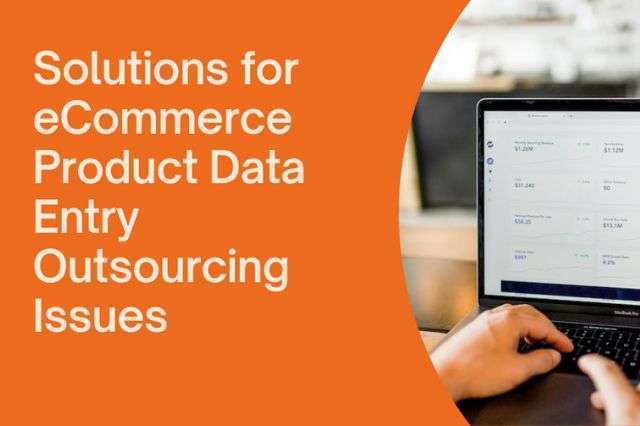Outsourcing eCommerce Product Data Entry Services: Challenges & Solutions
In the digital age, eCommerce has become an essential part of many businesses, allowing them to reach a wider audience and increase sales. However, managing product data entry for eCommerce can get time-consuming and tedious. This is why many companies outsource this task to third-party providers. While outsourcing eCommerce product data entry services can bring many benefits, such as cost savings and increased efficiency, it can pose several challenges as well.
In this article, we will explore some of the common challenges companies face when outsourcing eCommerce product data entry services and provide solutions to overcome them.
1. Finding a Trustworthy Vendor
The outsourcing process becomes easy when you hire a service that is worth your time and money. Unfortunately, as a seller, you may end up choosing the wrong company due to a lack of proper information. This can be especially challenging when dealing with new vendors, as the seller may not have any prior experience or knowledge about the vendor’s business practices.
This includes their business practices, reputation, and financial stability, making it difficult to assess their trustworthiness. The seller may not be aware of the vendor’s track record or the quality of their products or services, which can increase the risk of doing business with them.
Solution – Perform Deep Research
Before outsourcing to any service provider, you need to perform research and evaluation of factors such as the firm’s track record, its reputation in the market, the number and size of projects completed, the availability of cutting-edge technology, etc. Doing this will answer all your questions regarding the company’s worthiness as a partner for your business. Moreover, if you still struggle with making decisions, you can always ask for referrals from other reputed companies in the market.
2. Security and Privacy Concerns
Outsourcing your business operations involves giving access to your business assets, including sensitive information and intellectual property. For instance, if you are a multi-channel seller registered with Amazon, Shopify, and eBay, you must provide the seller ID credential to the outsourcing company to list your product.
Such kind of sensitive information needs to be protected at all cost. Moreover, there are higher chances of data breaches if the outsourcing company’s systems aren’t well protected with the necessary measures.
Solution – Follow Proper Security Protocols
A seller should sign an NDA (Non-Disclosure Agreement) with the outsourcing partner to protect their data from leakage or misuse. Moreover, sellers can use blockchain technology to improve data security and privacy. Blockchain technology provides a decentralized, tamper-proof record of all data transactions, making it difficult for unauthorized users to access or modify sensitive information. This technology can also enable secure, peer-to-peer sharing of data between the seller and the partner, reducing the need for intermediaries and increasing the efficiency and security of the outsourcing process.
3. Language and Cultural Differences
When a company outsources its work, there are chances that it might not find a company in its locale. And if you choose to outsource to a foreign country, you will have to deal with cultural and linguistic differences that can create communication barriers. For example, it will get difficult to communicate technical information accurately to your partner who may not be fluent in English, which can result in errors and delays. Cultural differences can also affect the quality of the work, as different cultures have different work ethics and standards.
Solution – Standardize Your Communication Process
To deal with such a situation, you need to ensure that you have access to employees/ personnel in-house who can speak the same language as the outsourcing country, or you can also choose a common language like English to bridge the communication gap. The seller can even hire a professional translator with experience in both the parties’ industries and cultures. Moreover, you can agree on communication channels that work best for both parties, such as email, phone, or video conferencing. Make sure both parties understand the expectations for response times and frequency of communication.
4. Project Control Issues
When outsourcing a project or department, it can be difficult to exercise the same level of control that you would have over an in-house team. This lack of control can lead to issues with quality, as some outsourcing vendors may prioritize profitability over quality, which can negatively impact your service quality. Furthermore, a lack of control can also make it more challenging to implement changes to your company’s products and services with your outsourced team. This can reduce your business’s flexibility and productivity, as you may need to navigate through a series of communication channels and approvals before any changes can be made.
Solution – Look for an Experienced Service Provider
To deal with this problem, you need to find a company with years of experience in the field that meets your requirements/needs. These companies have the particular knowledge and mindset on how to cooperate with a client that is just starting with outsourcing tasks. They will undoubtedly keep you updated on the progress of the process. This will give you the impression that you have significant influence over the project.
Moreover, you can also use online directories, referrals from industry contacts, and professional associations to find a reliable outsourcing service provider. It’s also important to conduct background checks and due diligence on potential vendors, including reviewing their contracts and service level agreements, to ensure that they meet the required standards and expectations.
5. Unexpected and Hidden Charges
Unexpected and hidden charges mean charges for additional services or features that were not originally discussed or mentioned in the paper. This happens due to a lack of transparency, leading to difficulties in budgeting and planning for expenses. Providers may use different payment structures, such as hourly rates, fixed rates, or milestone payments, which can add to the confusion when comparing prices and budgeting for the service. Currency conversion fees can also increase when outsourcing to a provider in a different country.
Solution – Maintain Written Expectations Between You and The Provider
To overcome these challenges, it’s important to establish clear expectations with the provider and to have a written agreement that outlines all the services and costs involved. Additionally, it’s important to conduct due diligence and research potential providers thoroughly to ensure that they have a reputation for being transparent and honest about their pricing structures. By taking these steps, buyers can avoid unexpected and hidden charges and ensure that they are getting the service they need at a fair price.
6. Differences in Time Zones
When working with an outsourcing company, one of the main challenges that you may encounter is time zone differences. This can create several difficulties, such as coordinating schedules and meetings between the two parties. This can result in delays and missed opportunities for collaboration. Moreover, communication also becomes more difficult due to the limited window of overlap in working hours. This can result in slower response times and can make it harder to resolve issues promptly.
Solution – Agree on a Communication Schedule
To overcome these challenges, it’s important to establish clear communication channels, set expectations around response time and turnaround time, and schedule meetings and calls in advance to ensure all parties can participate. You can choose a common time for the parties and use different video conferencing tools to communicate. For example, collaboration tools like Slack or Microsoft Teams can facilitate real-time communication and ensure everyone is on the same page.
7. Poor Knowledge Transfer
Poor knowledge transfer can lead to a host of problems for both parties, including incomplete documentation and missed expectations. From the client’s perspective, poor knowledge transfer can be frustrating and time-consuming. If the vendor (you) does not keep clear and detailed documentation, it can be challenging to understand the project’s features and scripts after the relationship ends. On the other hand, from the vendor’s (yours) perspective, inheriting an ongoing project without a transparent knowledge transfer procedure can be overwhelming and may result in failure to meet client expectations.
Solution – Create a Clear and Extensive Documentation Plan
To overcome these challenges, you must provide detailed information on the project’s features, technology, and code logic. This documentation should be detailed enough so the outsourcing vendor can easily grasp the project’s requirements and specifications. In case the documentation is not enough, organize calls or meetings with the outsourcing company, Data entry experts, or their manager to discuss hidden pitfalls and answer all the questions. This will help prevent misunderstandings and missed expectations, ultimately resulting in a successful outsourcing project.
Conclusion
Every organization faces different types of challenges when they hire and work with an outsourcing company. What matters is how you deal with the problems. There is always a simple solution to such a problem – Communication.
Clear and open communication can help bridge any gaps that may exist between the two parties and facilitate collaboration toward finding solutions to challenges. By maintaining regular communication and updates, both parties can stay informed about progress, identify potential issues early on, and work together to resolve them.
Moreover, communication can help establish clear expectations, goals, and quality standards from the outset, ensuring that both parties are on the same page and aligned toward achieving mutual objectives.
While there may be different types of challenges that arise when opting for an eCommerce product entry service, the key is to approach them proactively with a solution-oriented mindset, leveraging clear and open communication as a tool to foster collaboration and build stronger working relationships.





